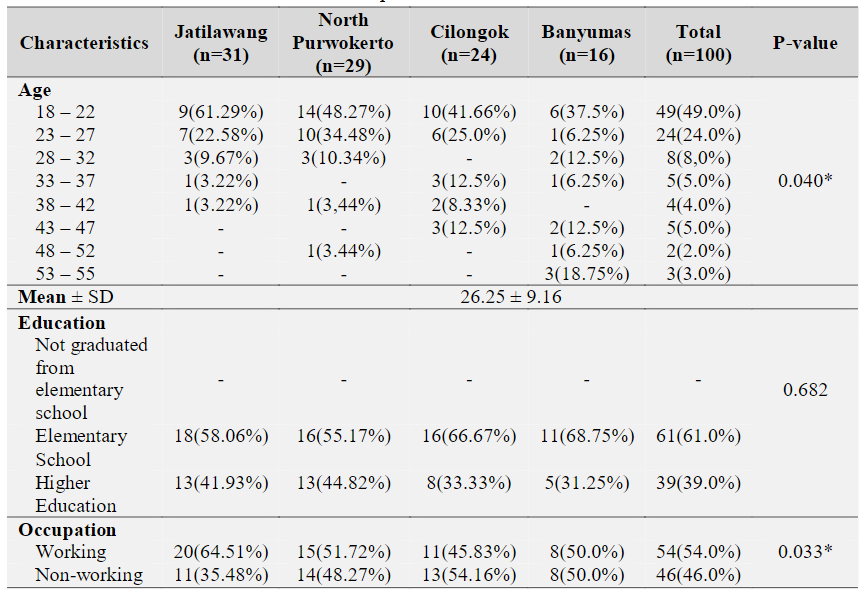Main Article Content
Abstract
Acne vulgaris is a chronic obstructive and inflammatory skin disease. It occurs in almost all adolescents with a prevalence of 90%. Powder is the most widely used cosmetic in the long term and one of the causes of Acne vulgaris which causes occlusion of pores on the skin surface. The purpose of this study was to analyze the effect of the level of knowledge, attitudes and behavior of choosing the type of powder on the incidence of acne vulgaris in Banyumas Regency. This study was an observational study with data collection techniques using cluster sampling and sampling technique by accidental sampling. The level of knowledge of women in the Banyumas Regency was dominated by the high category as many as 64 respondents (64.0%). The incidence of acne vulgaris out of 100 respondents, 67 (67.0%) of respondents had mild acne vulgaris, 22 respondents (22.0%) had moderate acne vulgaris and 1 respondent (1.0%) had severe acne vulgaris and the rest had no acne vulgaris. Chi-square analysis showed that there was a relationship between knowledge with behavior and attitude in choosing the type of powder to the incidence of acne vulgaris as evidenced by the p value of each variable, namely 0.044 and 0.028 (p <0.05). The level of knowledge with behavior and attitude in choosing the powder type had a significant relationship to the incidence of acne vulgaris in women in Banyumas Regency.
Keywords
Article Details

This work is licensed under a Creative Commons Attribution-NonCommercial 4.0 International License.
References
- Ahmad, A. N., Abd Rahman, A., & Ab Rahman, S. (2015). Assessing knowledge and religiosity on consumer behavior towards halal food and cosmetic products. International Journal of Social Science and Humanity, 5(1), 10.
- Andriana, R., Effendi, A., & Berawi, K. (2014). Hubungan antara penggunaan kosmetik wajah terhadap kejadian akne vulgaris pada mahasiswi Fakultas Kedokteran Universitas Lampung. Jurnal Majority, 3(1).
- Ardiansyah, F. (2019). Hubungan antara pengetahuan, sikap dan perilaku dengan derajat keparahan akne vulgaris pada siswa SMA. SKRIPSI-2018.
- Ayudianti, P., & Indramaya, D. M. (2014). Studi retrospektif: Faktor pencetus akne vulgaris. Berkala Ilmu Kesehatan Kulit Dan Kelamin, 26(1), 1–7.
- Bayu, K. (2020). Hubungan penggunaan bedak tabur dan bedak padat dengan kejadian akne vulgaris pada remaja wanita. SKRIPSI-2019.
- George, R. M., & Sridharan, R. (2018). Factors aggravating or precipitating acne in Indian adults: a hospital-based study of 110 cases. Indian Journal of Dermatology, 63(4), 328.
- Kabau, S. (2012). Hubungan Antara Pemakaian Jenis Kosmetik dengan Kejadian Akne Vulgaris (Skripsi). Semarang: Universitas Diponegoro.
- Munira, M., Fardilla, C., Zakiah, N., Rasidah, R., & Nasir, M. (2020). Pengaruh Lama Pemakaian Sediaan Kosmetik Bedak Padat Terhadap Cemaran Mikroba. Indonesian Journal of Pharmacy and Natural Product, 3(1).
- Notoatmodjo, S. (2012). Metodologi penelitian kesehatan (Cetakan VI). Jakarta: Penerbit PT. Rineka Cipta.
- Novitri, G., & Afriadi, A. (2016). Formulasi Sediaan Bedak Kompak Pati Bengkoang (Pachyrizhus Erosus L) Sebagai Pencerah Kulit Wajah. Jurnal Dunia Farmasi, 1(1), 15–21.
- Ompi, E. E., David, L., & Opod, H. (2016). Hubungan tingkat kepercayaan diri dengan jerawat (acne vulgaris) pada remaja di SMAN 7 Manado. EBiomedik, 4(1).
- Ravisankar, P., Koushik, O. S., Himaja, V., Ramesh, J., & Pragna, P. (2015). Acne-causes and amazing remedial measures for acne. J Pharm Res, 5.
- Sibero, H. T., Sirajudin, A., & Anggraini, D. I. (2019). Prevalensi dan gambaran epidemiologi akne vulgaris di Provinsi Lampung. Jurnal Kedokteran Universitas Lampung, 3(2), 308–312.
- Sifatullah, N., & Zulkarnain, Z. (2021). Jerawat (Acne vulgaris): Review penyakit infeksi pada kulit. Prosiding Seminar Nasional Biologi, November, 19–23.
- Wasiso, S. S. (2010). Perbandingan Antara Pemakaian Bedak Tabur dan Bedak Padat dengan Timbulnya Acne Vulgaris pada Karyawati Toko Luwes Gading Surakarta. Universitas Muhammadiyah Surakarta.
